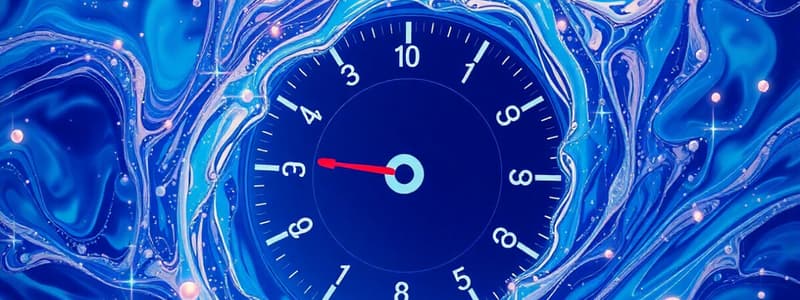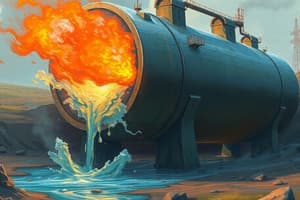Podcast
Questions and Answers
What are the units of pressure in the SI system?
What are the units of pressure in the SI system?
- kg/m<sup>2</sup> (correct)
- N/m<sup>2</sup> (correct)
- kg/s<sup>2</sup>
- m/s<sup>2</sup>
What is the relationship between absolute pressure (Pabs), gage pressure (Pg), and atmospheric pressure (Patm)?
What is the relationship between absolute pressure (Pabs), gage pressure (Pg), and atmospheric pressure (Patm)?
- P<sub>abs</sub> = P<sub>g</sub> + P<sub>atm</sub> (correct)
- P<sub>atm</sub> = P<sub>abs</sub> - P<sub>g</sub>
- P<sub>atm</sub> = P<sub>g</sub> - P<sub>abs</sub>
- P<sub>abs</sub> = P<sub>g</sub> - P<sub>atm</sub>
Which of the following units is NOT a common unit for pressure?
Which of the following units is NOT a common unit for pressure?
- kg/s (correct)
- kgf/cm<sup>2</sup>
- lbf/ft<sup>2</sup>
- 10<sup>3</sup> Pa
What is the pressure at a point in a stationary fluid called?
What is the pressure at a point in a stationary fluid called?
What is the relationship between pressure and depth in a fluid?
What is the relationship between pressure and depth in a fluid?
What is the principle that states that pressure at a point in a fluid is the same in all directions?
What is the principle that states that pressure at a point in a fluid is the same in all directions?
Which equation is obtained from the equilibrium of forces in the x-direction for the differential element in the proof of Pascal's Law?
Which equation is obtained from the equilibrium of forces in the x-direction for the differential element in the proof of Pascal's Law?
A barometer is used to measure:
A barometer is used to measure:
Why is pressure considered a scalar quantity for a stationary fluid?
Why is pressure considered a scalar quantity for a stationary fluid?
In a connected fluid under static conditions, the pressure at the same height from the free surface is:
In a connected fluid under static conditions, the pressure at the same height from the free surface is:
What is the principle behind mechanical advantage, as applied in the context of hydraulic systems?
What is the principle behind mechanical advantage, as applied in the context of hydraulic systems?
What is the value of 1 ban expressed in Pa?
What is the value of 1 ban expressed in Pa?
In the provided example problem, why is the pressure at point 'c' greater than the pressure at point 'b'?
In the provided example problem, why is the pressure at point 'c' greater than the pressure at point 'b'?
In the example problem, how is the absolute pressure at point '1' calculated?
In the example problem, how is the absolute pressure at point '1' calculated?
What is the principle behind the formula △P = P2 - P1 = - Pg h?
What is the principle behind the formula △P = P2 - P1 = - Pg h?
Flashcards
Variation of Pressure with Depth
Variation of Pressure with Depth
Describes how pressure changes with depth in a fluid due to gravity.
Connected Fluid Pressure
Connected Fluid Pressure
Pressure at the same height in connected fluids is equal.
Pressure Absolute Equation
Pressure Absolute Equation
P_abs = P_atm + pgh, relates absolute pressure to atmospheric pressure and fluid height.
Mechanical Advantage
Mechanical Advantage
Signup and view all the flashcards
Barometer
Barometer
Signup and view all the flashcards
Manometers
Manometers
Signup and view all the flashcards
Layered Liquids Pressure
Layered Liquids Pressure
Signup and view all the flashcards
Pressure Calculation Example
Pressure Calculation Example
Signup and view all the flashcards
Pressure
Pressure
Signup and view all the flashcards
Units of Pressure
Units of Pressure
Signup and view all the flashcards
Absolute Pressure
Absolute Pressure
Signup and view all the flashcards
Gage Pressure
Gage Pressure
Signup and view all the flashcards
Pressure at a point
Pressure at a point
Signup and view all the flashcards
Pascal's Law
Pascal's Law
Signup and view all the flashcards
Pressure Conversion
Pressure Conversion
Signup and view all the flashcards
Density of liquids
Density of liquids
Signup and view all the flashcards
Study Notes
Pressure
- Pressure is defined as the normal force exerted by a fluid per unit area.
- SI unit: Pascal (Pa) = N/m². Common units include MPa and kPa.
- USCU unit: lbf/ft² Other units include kgf/cm².
- 1 slug = mass in USCU
- 1 lbf = 1 lbm x 32.2 ft/s²
- 1 lbf/in² = 1 psi
- Conversions between units are included in the document.
Absolute vs. Gauge Pressure
- Absolute pressure: Pressure relative to a vacuum.
- Gauge pressure: Pressure relative to atmospheric pressure.
- Pabs = Pg + Patm
Pressure at a point in a fluid
- Pressure at a point in a stationary fluid is the same in all directions at that depth.
- A scalar quantity for a stationary fluid
Proof
- The sum of forces in any direction is zero.
- Pressure is the same at a given depth, irrespective of direction.
Layered liquids
- For layered liquids, pressure at a certain depth is determined by the layers above it.
- The pressure from each layer is summed at that point.
- Pressure increases with depth in each layer.
Manometers
- Manometers measure pressure differences between two points.
- Pgas = Pabs = Patm + pgh (p = density, g = acceleration due to gravity, h = height of column).
- A device used to measure pressure
- Mercury or other liquids used in manometers.
Studying That Suits You
Use AI to generate personalized quizzes and flashcards to suit your learning preferences.




